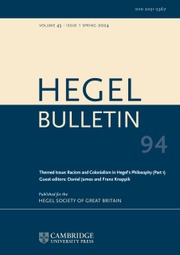No CrossRef data available.
Article contents
Art and Ethical Life: The Social and Historical Background to Hegel's Reflections on Ancient and Modern Literature in the Mit- and Nachschriften of his Lectures on Aesthetics
Published online by Cambridge University Press: 22 April 2013
Abstract
In 1835, a few years after Hegel's death, one of his students, Heinrich Gustav Hotho, put together the first printed edition of the lectures on aesthetics, using Hegel's own lecture notes, which have mostly disappeared, and various student transcripts (Mit- and Nachschriften) of the lectures that Hegel gave on the philosophy of art in Berlin in 1820/21, 1823, 1826 and 1828/29. Hotho made some minor revisions to this edition in 1843 and in the following year. The revised edition of the lectures has until recently formed the basis of all subsequent editions of Hegel's lectures on aesthetics and, consequently, of most previous interpretations of his aesthetics. Hotho's edition of the lectures, however, has been shown to be highly problematic. To begin with, there are the various editorial interventions that Hotho made in order to give Hegel's lectures on aesthetics the systematic form he thought they lacked, while other interventions include various evaluative judgements concerning particular works of art and even some of Hotho's own ideas concerning art.
As regards the systematic structure of Hotho's edition of Hegel's lectures on aesthetics, this edition divides the lectures into three main parts, whereas the available student transcripts of the lectures show that only the last series of lectures from 1828/29 were given such a three-part structure by Hegel himself.
- Type
- Research Article
- Information
- Bulletin of the Hegel Society of Great Britain , Volume 31 , Special Issue 2: Special Issue on Hegel and Literature , Autumn/Winter 2010 , pp. 83 - 100
- Copyright
- Copyright © The Hegel Society of Great Britain 2010




